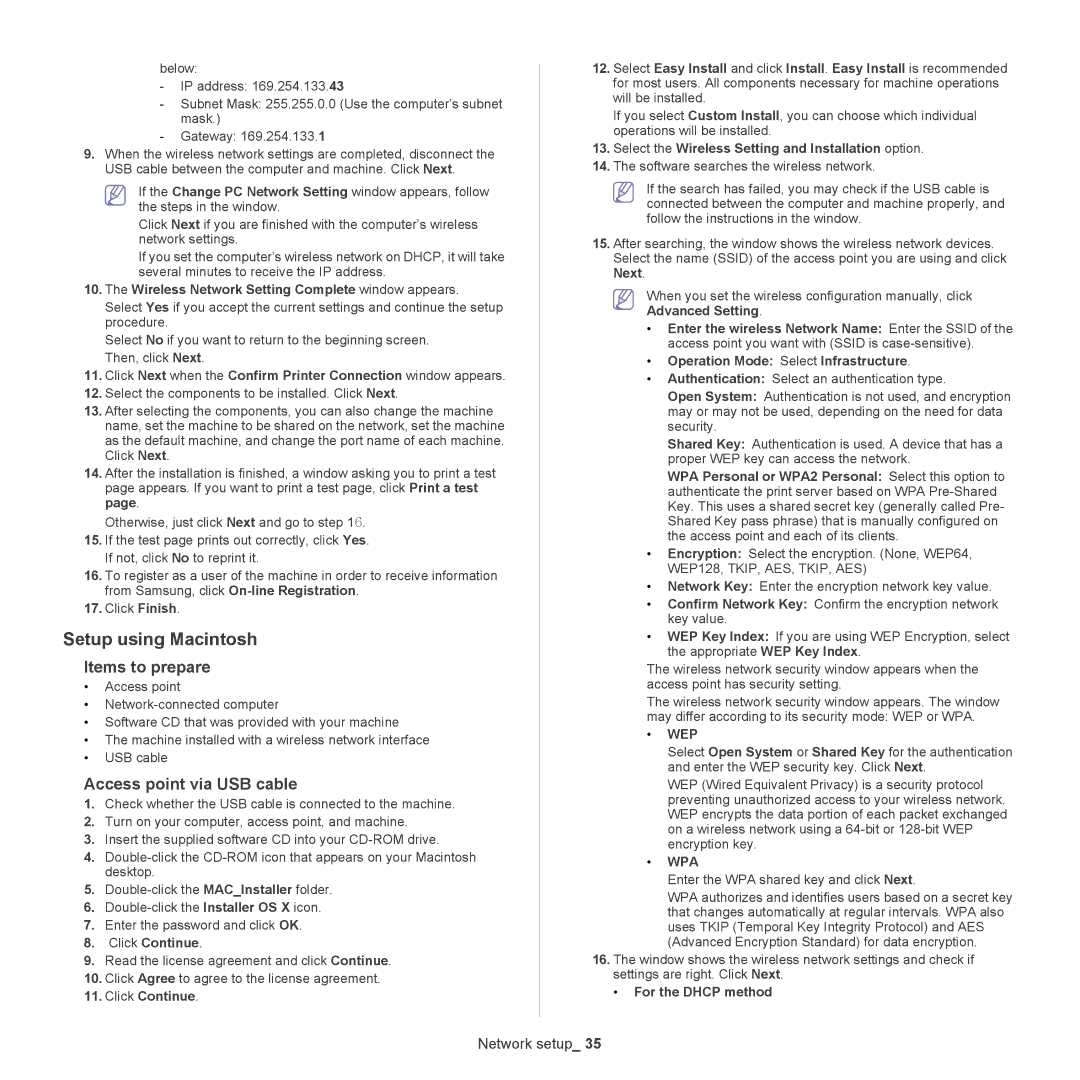
below:
-IP address: 169.254.133.43
-Subnet Mask: 255.255.0.0 (Use the computer’s subnet mask.)
-Gateway: 169.254.133.1
9.When the wireless network settings are completed, disconnect the USB cable between the computer and machine. Click Next.
If the Change PC Network Setting window appears, follow the steps in the window.
Click Next if you are finished with the computer’s wireless network settings.
If you set the computer’s wireless network on DHCP, it will take several minutes to receive the IP address.
10.The Wireless Network Setting Complete window appears.
Select Yes if you accept the current settings and continue the setup procedure.
Select No if you want to return to the beginning screen. Then, click Next.
11.Click Next when the Confirm Printer Connection window appears.
12.Select the components to be installed. Click Next.
13.After selecting the components, you can also change the machine name, set the machine to be shared on the network, set the machine as the default machine, and change the port name of each machine. Click Next.
14.After the installation is finished, a window asking you to print a test page appears. If you want to print a test page, click Print a test page.
Otherwise, just click Next and go to step 16.
15.If the test page prints out correctly, click Yes. If not, click No to reprint it.
16.To register as a user of the machine in order to receive information from Samsung, click
17.Click Finish.
Setup using Macintosh
Items to prepare
•Access point
•
•Software CD that was provided with your machine
•The machine installed with a wireless network interface
•USB cable
Access point via USB cable
1.Check whether the USB cable is connected to the machine.
2.Turn on your computer, access point, and machine.
3.Insert the supplied software CD into your
4.
5.
6.
7.Enter the password and click OK.
8.Click Continue.
9.Read the license agreement and click Continue.
10.Click Agree to agree to the license agreement.
11.Click Continue.
12.Select Easy Install and click Install. Easy Install is recommended for most users. All components necessary for machine operations will be installed.
If you select Custom Install, you can choose which individual operations will be installed.
13.Select the Wireless Setting and Installation option.
14.The software searches the wireless network.
If the search has failed, you may check if the USB cable is connected between the computer and machine properly, and follow the instructions in the window.
15.After searching, the window shows the wireless network devices. Select the name (SSID) of the access point you are using and click Next.
When you set the wireless configuration manually, click Advanced Setting.
•Enter the wireless Network Name: Enter the SSID of the access point you want with (SSID is
•Operation Mode: Select Infrastructure.
•Authentication: Select an authentication type.
Open System: Authentication is not used, and encryption may or may not be used, depending on the need for data security.
Shared Key: Authentication is used. A device that has a proper WEP key can access the network.
WPA Personal or WPA2 Personal: Select this option to authenticate the print server based on WPA
•Encryption: Select the encryption. (None, WEP64, WEP128, TKIP, AES, TKIP, AES)
•Network Key: Enter the encryption network key value.
•Confirm Network Key: Confirm the encryption network key value.
•WEP Key Index: If you are using WEP Encryption, select the appropriate WEP Key Index.
The wireless network security window appears when the access point has security setting.
The wireless network security window appears. The window may differ according to its security mode: WEP or WPA.
•WEP
Select Open System or Shared Key for the authentication and enter the WEP security key. Click Next.
WEP (Wired Equivalent Privacy) is a security protocol preventing unauthorized access to your wireless network. WEP encrypts the data portion of each packet exchanged on a wireless network using a
•WPA
Enter the WPA shared key and click Next.
WPA authorizes and identifies users based on a secret key that changes automatically at regular intervals. WPA also uses TKIP (Temporal Key Integrity Protocol) and AES (Advanced Encryption Standard) for data encryption.
16.The window shows the wireless network settings and check if settings are right. Click Next.
